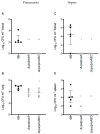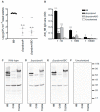Protective Effect of Nasal Colonisation with ∆cps/piaA and ∆cps/proABCStreptococcus pneumoniae Strains against Recolonisation and Invasive Infection
- PMID: 33804077
- PMCID: PMC8000150
- DOI: 10.3390/vaccines9030261
Protective Effect of Nasal Colonisation with ∆cps/piaA and ∆cps/proABCStreptococcus pneumoniae Strains against Recolonisation and Invasive Infection
Abstract
Rationale: Nasopharyngeal administration of live virulence-attenuated Streptococcus pneumoniae strains is a potential novel preventative strategy. One target for creating reduced virulence S. pneumoniae strains is the capsule, but loss of the capsule reduces the duration of S. pneumoniae colonisation in mice which could impair protective efficacy against subsequent infection.
Objectives: To assess protective efficacy of nasopharyngeal administration of unencapsulated S. pneumoniae strains in murine infection models.
Methods: Strains containing cps locus deletions combined with the S. pneumoniae virulence factors psaA (reduces colonisation) or proABC (no effect on colonisation) were constructed and their virulence phenotypes and ability to prevent recolonisation or invasive infection assessed using mouse infection models. Serological responses to colonisation were compared between strains using ELISAs, immunoblots and 254 S. pneumoniae protein antigen array.
Measurements and main results: The ∆cps/piaA and ∆cps/proABC strains were strongly attenuated in virulence in both invasive infection models and had a reduced ability to colonise the nasopharynx. ELISAs, immunoblots and protein arrays showed colonisation with either strain stimulated weaker serological responses than the wild type strain. Mice previously colonised with these strains were protected against septicaemic pneumonia but, unlike mice colonised with the wild type strain, not against S. pneumoniae recolonisation.
Conclusions: Colonisation with the ∆cps/piaA and ∆cps/proABC strains prevented subsequent septicaemia, but in contrast, to published data for encapsulated double mutant strains they did not prevent recolonisation with S. pneumoniae. These data suggest targeting the cps locus is a less effective option for creating live attenuated strains that prevent S. pneumoniae infections.
Keywords: Streptococcus pneumoniae; capsule; colonisation; immunity; proABC; psaA; vaccine.
Conflict of interest statement
The authors declare no conflict of interest.
Figures







Similar articles
-
Protective contributions against invasive Streptococcus pneumoniae pneumonia of antibody and Th17-cell responses to nasopharyngeal colonisation.PLoS One. 2011;6(10):e25558. doi: 10.1371/journal.pone.0025558. Epub 2011 Oct 7. PLoS One. 2011. PMID: 22003400 Free PMC article.
-
Contributions of capsule, lipoproteins and duration of colonisation towards the protective immunity of prior Streptococcus pneumoniae nasopharyngeal colonisation.Vaccine. 2012 Jun 22;30(30):4453-9. doi: 10.1016/j.vaccine.2012.04.080. Epub 2012 May 3. Vaccine. 2012. PMID: 22561489 Free PMC article.
-
A Randomized Controlled Clinical Trial of Nasal Immunization with Live Virulence Attenuated Streptococcus pneumoniae Strains Using Human Infection Challenge.Am J Respir Crit Care Med. 2023 Oct 15;208(8):868-878. doi: 10.1164/rccm.202302-0222OC. Am J Respir Crit Care Med. 2023. PMID: 37556679 Clinical Trial.
-
Mechanisms of Naturally Acquired Immunity to Streptococcus pneumoniae.Front Immunol. 2019 Mar 1;10:358. doi: 10.3389/fimmu.2019.00358. eCollection 2019. Front Immunol. 2019. PMID: 30881363 Free PMC article. Review.
-
Colonisation endpoints in Streptococcus pneumoniae vaccine trials.Vaccine. 2013 Dec 17;32(1):153-8. doi: 10.1016/j.vaccine.2013.08.061. Epub 2013 Sep 7. Vaccine. 2013. PMID: 24016803 Review.
Cited by
-
A Trivalent Live Vaccine Elicits Cross-Species Protection Against Acute Otitis Media in a Murine Model.Vaccines (Basel). 2024 Dec 19;12(12):1432. doi: 10.3390/vaccines12121432. Vaccines (Basel). 2024. PMID: 39772092 Free PMC article.
-
Non-capsular based immunization approaches to prevent Streptococcus pneumoniae infection.Front Cell Infect Microbiol. 2022 Sep 26;12:949469. doi: 10.3389/fcimb.2022.949469. eCollection 2022. Front Cell Infect Microbiol. 2022. PMID: 36225231 Free PMC article. Review.
-
Naturally acquired adaptive immunity to Streptococcus pneumoniae is impaired in rheumatoid arthritis patients.Clin Transl Immunology. 2024 Oct 15;13(10):e70012. doi: 10.1002/cti2.70012. eCollection 2024. Clin Transl Immunology. 2024. PMID: 39416767 Free PMC article.
-
Streptococcus pneumoniae serotype distribution in low- and middle-income countries of South Asia: Do we need to revisit the pneumococcal vaccine strategy?Hum Vaccin Immunother. 2025 Dec;21(1):2461844. doi: 10.1080/21645515.2025.2461844. Epub 2025 Feb 25. Hum Vaccin Immunother. 2025. PMID: 39999432 Free PMC article. Review.
-
Strain Specific Variations in Acinetobacter baumannii Complement Sensitivity.Front Immunol. 2022 Jun 22;13:853690. doi: 10.3389/fimmu.2022.853690. eCollection 2022. Front Immunol. 2022. PMID: 35812377 Free PMC article.
References
-
- Bonten M.J., Huijts S.M., Bolkenbaas M., Webber C., Patterson S., Gault S., Van Werkhoven C.H., Van Deursen A.M., Sanders E.A., Verheij T.J., et al. Polysaccharide conjugate vaccine against pneumococcal pneumonia in adults. N. Engl. J. Med. 2015;372:1114–1125. doi: 10.1056/NEJMoa1408544. - DOI - PubMed
Grants and funding
LinkOut - more resources
Full Text Sources
Other Literature Sources

